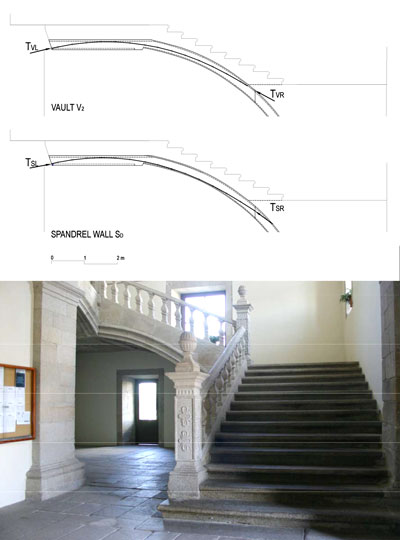The grand Staircase of the Colegio del Cardenal in Monforte de Lemos (Spain): revisiting a daring structure
Authors: Rosana Guerra and Paula Fuentes
Little is known about the trade techniques applied in the construction of stone staircases in C16 and C17 in Spain. Staircases are studied in the main treatises which, recognizing its complexity, linger on explaining different layouts and on detailing their intricate stone cuts. The unusual opportunity of removing the stone threads in the grand staircase of the Colegio del Cardenal, in Monforte, due to a structural restoration, unveiled two construction traits that cannot be found in the treatises.
The Colegio staircase is a three flight open-newel type. The second and third flights are supported on cylindrical rampant vaults; the first rests on a massive spandrel. There are no other supports apart from this spandrel and the perimeter walls. The flights are about 3 m wide. It was a marked drop of its inner edge what caused its restoration in 1997.
Lifted the threads, the two aforementioned traits came up. The first was the ingenious structural solution to support the flights: the hidden extrados protruding from the first (lower) course of the third vault, high enough to develop a transversal arch behaviour on which this upper flight rests. The second, the presence of flint wedges hammered inside the joints to pre-stress the shallow vaults prior to their decentering.
At the time, a structural assessment was made and published by the engineering team in charge of the restoration works. The assessment resorted to a finite elements model.
In this study, a new approach is developed under the Limit Analysis theoretical frame. This new study (1) starts with a geometrical survey of the visible parts, (2) gathers and matches the existing documentation from the 1997 restoration, (3) shows the equilibrium state by tracing the possible lines of thrust, and (4) considers the pre-stressing effect of the flint wedges in the equilibrium, and calculates the resulting new set of lines of thrust.
Neither the protruding arch, nor the flint wedges have been described in any document. Since both are hidden characteristics, it is not possible to know if they were a common practice for masons. Even though the restoration of another Spanish coeval staircase has shown similar solutions, new discoveries will be needed to establish whether we are in front of a common technique for staircase construction.
Guerra-Pestonit, Rosa Ana and Paula Fuentes. 2015. “The grand Staircase of the Colegio del Cardenal in Monforte de Lemos (Spain): revisiting a daring structure.” In Proceedings of the Second Conference of the Construction Society, 67-77, edited by James C W Campbell et al. Cambridge: Construction History Society.











